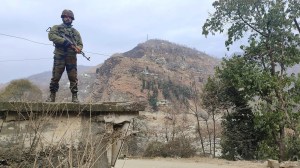- India
- International
Heat domes, anticyclones and climate change: What’s causing heat waves across the world?
At present, heat domes and anticyclones are responsible for the occurrence of heat waves in several parts of the world. Although they don’t occur due to climate change, they have become more intense and longer as a result of soaring global temperatures, scientists and experts believe.
 A tourist uses a handfan inside Stoa of Attalos, at ancient Agora, in Athens, on Thursday, July 20, 2023. (AP Photo/Petros Giannakouris)
A tourist uses a handfan inside Stoa of Attalos, at ancient Agora, in Athens, on Thursday, July 20, 2023. (AP Photo/Petros Giannakouris) The US scientific and regulatory agency National Oceanic and Atmospheric Administration (NOAA) announced on Thursday (July 20) that the last month was the Earth’s hottest June since the record-keeping of global temperatures began 174 years ago. The update has arrived as 18 out of the first 20 days of July have witnessed highest ever average daily global temperatures.
According to scientists and experts, a number of factors are fueling the soaring temperatures in different parts of the world. While El Nino conditions, which have developed for the first time in seven years, are partly responsible for triggering extreme heat, continents like North America, Africa, Asia and Europe have been battered by scorching heat waves, caused, in most cases, by either formation of heat domes or arrival of anticyclones. Not only this, record high sea surface temperatures have also worsened the situation. But at the heart of the present crisis is climate change, which has increased the frequency and intensity of extreme weather events like heat waves and mass scale floods.
The dangerous cocktail of heat domes, anticyclones and climate change
Most parts of the world are currently experiencing sweltering heat due to the onset of heat waves but their cause remains different across regions. While in the USA and Algeria, heat domes are responsible for unleashing heat waves, Europe has suffered due to the arrival of two consecutive anticyclones that originated in Africa. But what are heat domes and anticyclones? And how do they produce heat waves?
An anticyclone, also known as a high-pressure system, is essentially an area of high pressure in which the air goes downwards towards the Earth’s surface. As the air sinks, its molecules get compressed, which increases the pressure, making it warmer. This causes dry and hot weather. The winds remain calm and gentle during an anticyclone, and there is almost no formation of clouds because here the air sinks rather than rises.

A heat dome, on the other hand, occurs when an area of high-pressure stays over a region for days and weeks. It traps warm air, just like a lid on a pot, for an extended period. The longer that air remains trapped, the more the sun works to heat the air, producing warmer conditions with every passing day. Heat domes, if they last for a long period, may cause deadly heat waves.
Although heat domes and anticyclones don’t occur due to climate change, they have become more intense and longer as a result of soaring global temperatures, scientists and experts believe. As the planet continues to get warmer, thanks to the unprecedented levels of greenhouse gases being released into the atmosphere, extreme weather events, much like those unfolding right now, will become more frequent. Moreover, if the Earth breaches the 1.5 degree Celsius global warming limit by the 2030s, there may be irrevocable damage to the ecosystem and geology, with millions, if not billions, of humans and other living beings, severely impacted.
Also, El Nino conditions are exacerbating the extreme heat around the world. Essentially a weather pattern that refers to an abnormal warming of surface waters in the equatorial Pacific Ocean, El Nino is known to “greatly increase the likelihood of breaking temperature records and triggering more extreme heat in many parts of the world and in the ocean,” a World Meteorological Organisation (WMO) report said.
Heat waves: The ‘silent killer’
Heat waves are particularly lethal when high temperatures combine with high humidity, which is commonly referred to as a wet bulb. In such conditions, sweat from the human body isn’t able to evaporate, failing to stabilise the body temperature, which could ultimately cause heat stroke — it takes place only when the body temperature goes above 40 degree Celsius — and even death.
Last month, more than 60 people died in Uttar Pradesh’s Ballia after the region was hit by a heat wave. The incident took place just two months after 13 people had died due to similar conditions at a large-scale event in Mumbai, Maharashtra. A new study, published last week, revealed that heat waves killed more than 60,000 in Europe last year.
The worst affected countries
In North America, a prolonged heat wave has covered a swath of the United States with parts like California, Florida, New Mexico and Arizona sweltering under a blazing sun. For instance, the city of Phoenix, Arizona, on July 18, logged a 19th consecutive day of temperature of 43.3 degree Celsius or above, breaking a record set in 1974. Mercury continued to rise in the city as on Thursday it touched 48.3 degree Celsius.
In its recent forecast, the WMO said the country’s southern, western and mid-western regions will continue to simmer in the following days, partly also due to unusually warm waters in the Gulf of Mexico and in the western Atlantic Ocean that would exacerbate humidity in coastal areas and thwart nighttime cooling.
Meanwhile, hot temperatures have sparked numerous wildfires in South California, including one in Riverside County that has burned more than 7,500 acres. Similarly, flames have erupted in neighbouring Canada, where so far nearly 25 million acres have already been burnt.
In Europe, countries like Italy and Greece have been gripped by two consecutive heat waves within two weeks. While the mercury in Italy’s island of Sardinia hit 47.7 degree Celsius on Thursday (July 20), in Greece, temperatures crossed the 40 degree Celsius mark, forcing authorities to shut down the Acropolis and other ancient sites for tourists on July 14. Authorities have also reported wildfires around Athens, where more than 7,400 acres of forest have been turned into ashes.
Dry spells have impacted Spain too as it witnessed 45.4 degree Celsius in the town of Figueres on July 18 — it was the highest temperature that the country has recorded since 1928. A wildfire has been blazing on La Palma, the most northwesterly of the country’s Canary Islands, since July 15. More than 500 firefighters, aided by several water-carrying helicopters, are trying to douse the flames.
In Asia, China, Iraq and Saudi Arabia remain some of the worst affected countries. Most significantly, a remote township in China saw temperatures touching 52 degree Celsius on July 16 — shattering the previous record of 50 degree Celsius that was set in 2015.
Record-breaking temperatures have been reported in North Africa’s Algeria, where experts suggest temperatures have crossed the 50 degree Celsius mark in the past few days. Authorities have raised the level of alert to the maximum in light of the soaring mercury. Tunisia is also impacted by severe heat with some parts of it reaching 49 degree Celsius.
More Explained
EXPRESS OPINION
Apr 05: Latest News
- 01
- 02
- 03
- 04
- 05










































